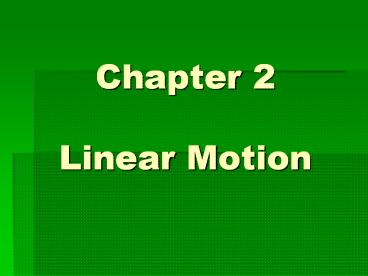Chapter 2 Linear Motion - PowerPoint PPT Presentation
Title:
Chapter 2 Linear Motion
Description:
Chapter 2 Linear Motion Motion of some form is responsible for nearly everything we see, do, or experience in our daily lives. Quantity divided by time is RATE Motion ... – PowerPoint PPT presentation
Number of Views:160
Avg rating:3.0/5.0
Title: Chapter 2 Linear Motion
1
Chapter 2Linear Motion
2
- Motion of some form is responsible for nearly
everything we see, do, or experience in our daily
lives. - Quantity divided by time is RATE
3
Motion is Relative - 2.1
- When we see things move in the world around us,
they are moving relative to us and our position. - It is important to realize that in relative to
the sun and stars everything on the earth is
moving. - In this class, when we talk about motion we will
be looking at it relative to the surface of the
earth.
4
SPEED 2.2
- SPEED is the measure of how fast something is
moving, or the rate at which a distance is
covered. - Speed distance / time
- The units for speed can be any measure of
distance over any measure of time. It is written
as Dist./Time - The speed of any object at any given instant is
its instantaneous speed.
5
Speed (cont.)
- The speed of any object over a period of time is
its average speed. - When distinguishing between instantaneous and
average speed think of a road trip. - The equation for average speed is total distance
divided by total time interval. - Speed Dist. / Time
6
Velocity 2.3
- There is a difference between speed and
velocity Speed is how fast you are
traveling Velocity is how fast you are traveling
and what direction you are going. This means
that your speed can be constant while your
velocity is changing if you are going around a
turn.
7
Velocity (cont.)
- Constant velocity means constant speed and
constant direction - Changing velocity can mean either speed or
direction are changing or both!
8
Acceleration 2.4
- When velocity is changing then we have
acceleration. Acceleration change in
velocity / time interval - Acceleration applies to both a increases and
decreases in speed (often times we use the term
deceleration when we talk about slowing down, but
in physics we use acceleration for both) - Acceleration also applies to change in direction.
- The units used is distance / time / time
- or distance / time2
9
Free Fall 2.5 How Fast
- When an object is dropped it falls, and as it
falls its speed increases. If we neglect air
resistance, we say it is free falling if no other
forces are acting on it except gravity. The
amount of time that has passed since the
beginning of the fall is the elapsed time.
10
Free Fall (cont.)
- To get the instantaneous speed of an object in
free fall that is dropped from rest we say
velocity equals acceleration times time, where
acceleration is due to gravity. - v gt V is velocity, g is acceleration
due to gravity, and t is elapsed time - This equation can be written as v at a is
acceleration an object undergoes
11
Free Fall (cont.)
- The acceleration due to gravity is equal to 9.8
m/s/s, which we commonly round to 10
m/s/s. This means for each second an object
falls, its instantaneous speed increases 10
m/s.
12
Free Fall (cont.)
- All rules for an object in free fall that is
falling downward also apply to an object in free
fall upwards, except in this case, the
acceleration due to gravity is negative and the
speed is decreases each second by 10 m/s.
13
Free Fall 2.6 How Far
- When looking at how far an object falls in free
fall it is important to remember the difference
between instantaneous and average speed. Remember
that average speed is how far an object has
traveled divided by the amount of time it has
been traveling. This means that after one
second an object in free fall is falling 10 m/s.
It started at 0 m/s. The average of 10 and 0 is
5, so the average speed for one second is 5 m/s.
14
Free Fall (cont.)
- Put this into the equation Average Velocity
distance traveled / time period - we get a distance of 5 m
- This could get complicated if we start looking at
longer time periods, because each second the
speed is changing. To deal with this we use the
following equation.
15
Free Fall (cont.)
- d vot ½ gt2 d is distance, g is
acceleration due to gravity, and t is the elapsed
time - The equation can also be written as d vot 1/2
at2
16
Graphs of Motion 2.7
- Some times it is easier to look at a graph to see
the relationships between distance, velocity, and
acceleration. Here are some guidelines for
looking at motion graphs - Distance VS Time graphs
- 1. a flat straight line indicates there is no
acceleration. - 2. A diagonal line indicates constant velocity
- 3. A curved line or a line that stops and starts
indicates there is some acceleration happening
17
Graphs of Motion
- Velocity VS Time graphs
- A flat line indicates there is motion, but it is
happening at a constant rate and there is no
acceleration. - A diagonal line indicates a constant acceleration
- A line that is not straight indicates an
acceleration that is not constant.
18
Air Resistance 2.8
- Air resistance changes the motion of all moving
objects.
19
(No Transcript)































